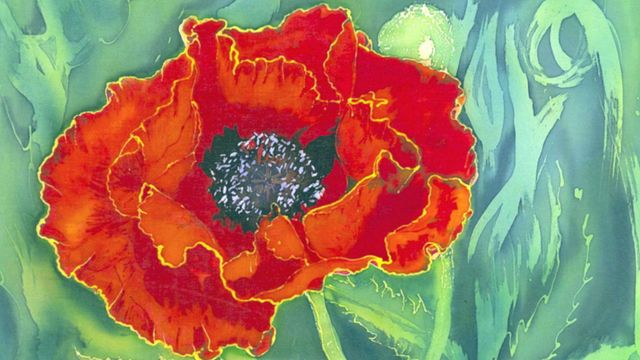Batik artist captures Scottish Highlands
Jane Lannagan is drawn to the Scottish Highlands for the multiple colors and textures which give her a constant source of inspiration.
Posted — UpdatedScotland is a magnet for artists because of its haunting beauty and its fleeting forms of light. I recently interviewed a very talented woman who takes advantage of these qualities. Jane Lannagan is drawn to the Scottish Highlands for the multiple colors and textures which give her a constant source of inspiration.
Jane grew up in an artistic family in Edinburgh. Family vacations were centered around the ramblings of her father who made a living sketching and painting images across Scotland. Eventually Jane would follow in her father’s footsteps. However, she would dabble in a different medium than her dad. The result is a unique and glorious gallery of work.
Jane Lannagan’s art seems like a perfect partner for a song I wrote about Scotland. The tune is titled “Bridge of Lochay.”
Q&A: Jane Lannagan
From an artistic family I learned very early to enjoy sketching and painting and still remember the pride I felt when my father framed one of my efforts.
My father, Tom Guise, was a prolific painter in oils, acrylics and watercolor and despite himself being self taught, successfully exhibited in the RSA in Edinburgh and had many one-man exhibitions in this country and in America.
I can remember watching him from an early age as he sat at his easel in the countryside. All our holidays were arranged around his painting!
I really think that batiking would have appealed to him. Born and brought up in Edinburgh, I spent my early working life as a medical laboratory technician. I did not go to Art College as my two sisters did, but later on during a diploma course in dress and design I discovered the art of batik and fell in love with its concept and have never stopped producing work during the past forty years.
Originally batik was an Eastern art form and used to decorate clothing materials using wax and dyes and until recently has had no recognition in the West.
I developed my own particular style over the years starting out with old white sheets, candle wax melted in a double boiler and applied with brushes and shop-bought dyes, and over time I sold my art. I bought a wax pot, proper batik wax, wax pens from Java and the Ukranian Bookshop and now use the finest Primissima cotton.
As the last colors achieved are the darkest, I have to think in the negative to get the final results, all the time bearing in mind that the resultant shades are an overlaying of dye colors.
In the image I select light could be constantly changing and so too will the scene. I use my camera to catch that exact moment and to record the light and color which had so impressed me. I do not slavishly copy the photo as I like to think that my picture is my interpretation of how I view the scene. By the nature of the technique I have to work in a studio where there are electrical points for my wax pot.
I felt very proud when I sold a picture in the Scottish Society of Artists in 2005 in Edinburgh and when the "Artist" magazine awarded me the Royal Talens Award in their annual exhibition.
The fact that you, Bill, want to link my art with your lovely music makes me happy and proud.
Apart from his encouragement, he scans my original work and makes prints and cards from them. He frames them, organizes exhibitions and wholesales the cards.
For me, the most amazing thing with this technique is that no matter how I have in my mind what the finished work should look like, it always ends up slightly different. I call it a technique with attitude for it comes out as it wants to and gives my work great fluidity.
My challenge is to have the public accept batik as a medium which can be fully appreciated alongside the more conventional techniques of oil and watercolor.
Related Topics
• Credits
Copyright 2024 by Capitol Broadcasting Company. All rights reserved. This material may not be published, broadcast, rewritten or redistributed.






